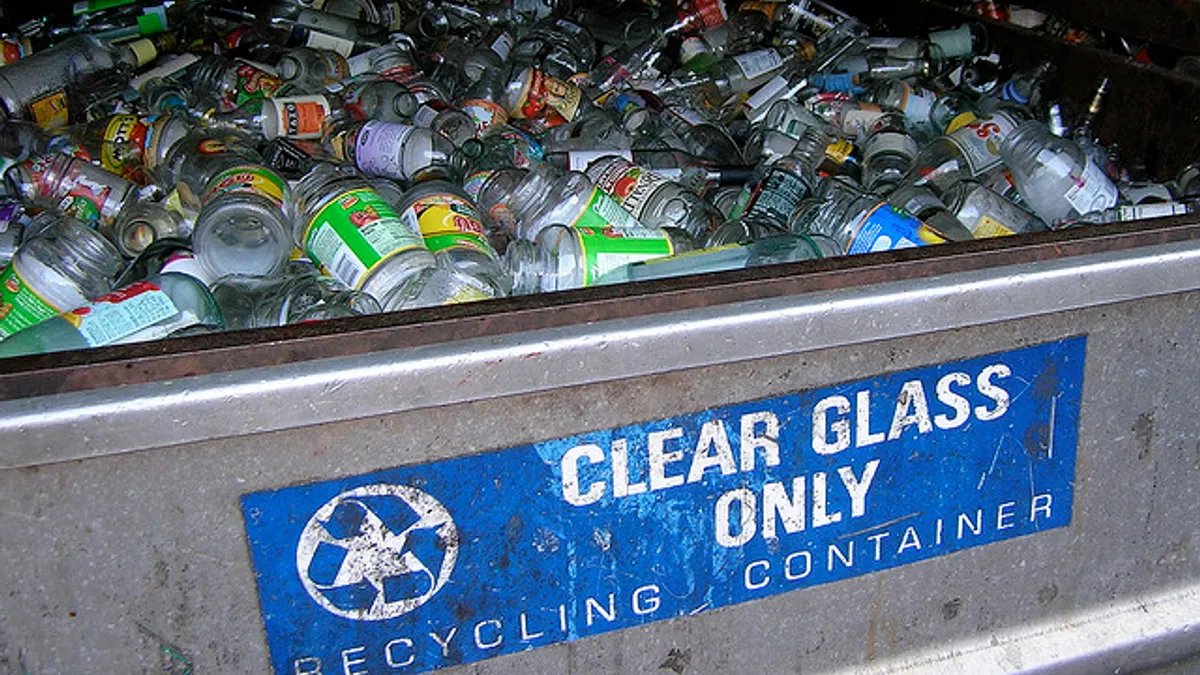The glass recycling market has recently been in a fragile state.
The commodity that has been seen as a prime example of a recyclable product is now becoming a nuisance — and hazard — for waste management companies and recycling facilities, specifically due to single-stream recycling.
"Glass has become the scourge of recycling ... You can't make money from it," Gray Russell, sustainability officer for Montclair, NJ, told The Wall Street Journal.
For many recyclers, this isn't true. By building a proper facility to recycle the glass — particularly by keeping it separate from other recyclables and processing it with the correct equipment — the commodity becomes profitable. Therefore as consumers have made it a habit to toss their glass in the recycling bin, companies like Clear Intentions have focused on glass recycling as their sole source of business in the market.
Only one solid waste management company, however, has gone above and beyond to push the envelope and build a glass recycling plant in addition to its daily waste management collections and operations: Cincinnati, OH-based Rumpke Waste and Recycling.
The rise of Rumpke's glass recycling business
Rumpke is the only solid waste management company in the country operating its own glass plant according to Steve Sargent, Rumpke’s director of recycling. The company banked on the notion that there was money in the glass recycling market, as long as they could find a way to recycle it — and therefore built its own glass recycling plant in Dayton, OH in 2003.
The solid waste management company brings in over 5,000 tons of glass a month — comprising 15% to 20% by weight of the material they collect — which comes from residential and commercial customers in four states.
"We are a single-stream processor and collector, so the glass comes in blended, and when we extract it from the recycling center it’s broken together by color, which we call mixed glass," said Sargent.
The company has invested nearly $5 million into their glass-processing plant since its launch. High-dollar technology like screening equipment enables glass to be processed while removing metal, food, and other contaminants. An optical scanner with infrared technology scans glass that is separated by color.
"We pick up [unseparated waste] curbside, separate and clean the glass at our MRF, which goes to our Dayton facility where we process it, and we sell it to two markets,” said Sargent of the Dayton operation, which has been recognized by the National Waste & Recycling Association and the National Recycling Coalition.
Rumpke’s deepest bread basket is fiberglass, comprising two-thirds of its market; the remaining third is the glass container market.
Contaminants are a problem
Over a ton of natural resources are conserved for every ton of glass recycled, including 1,300 pounds of sand, 410 pounds of soda ash, 380 pounds of limestone, and 160 pounds of feldspar, according to Keep America Beautiful’s website. Because recycling glass requires very little electricity, it both reduces carbon footprint and is easy on processors’ utility bills, though there are other expenses involved, largely tied to separating it from other materials.
In the beginning of its operation, there were a few problems that Rumpke faced — namely contaminants that couldn’t run through the system.
"We’ve learned a lot about providing clean material since then," said Sargent, adding that more sophisticated technology has helped. Rumpke can now run 25 tons per hour of unclean glass, recovering 80% to 85% of what they bring in using a glass beneficiation system from Australia.
Because glass is generally left in the single-stream collection programs in their Midwestern service area, Rumpke designed processing systems to effectively recover it, having invested $32 million in this endeavor at their single-stream MRF in Cincinnati.
Working with single-stream waste has had benefits and drawbacks
"On the positive side, it’s more efficient and cost effective in transportation. The challenge is we have to make sure people don’t put things in [their recycle bins] other than what’s on the acceptable list for contamination. Like, someone once threw in brake drums that clogged up our line. Some materials can harm equipment and contaminate other materials," said Sargent.
He has found glass to be a lucrative market, yet advises other MRFs to prepare before going into the business.
"What you need to do is go to the end market first. Find out who will take glass in your region and determine what quality they will take before you start a program. You have to know what to collect and how to handle it. Some [clients] may need color separated; others take mixed," he said.
He tells recyclers they can get an idea of what one of the glass purchasers — such as Strategic Materials, the country's largest recycled-glass processor — wants in the product by checking their websites.






















